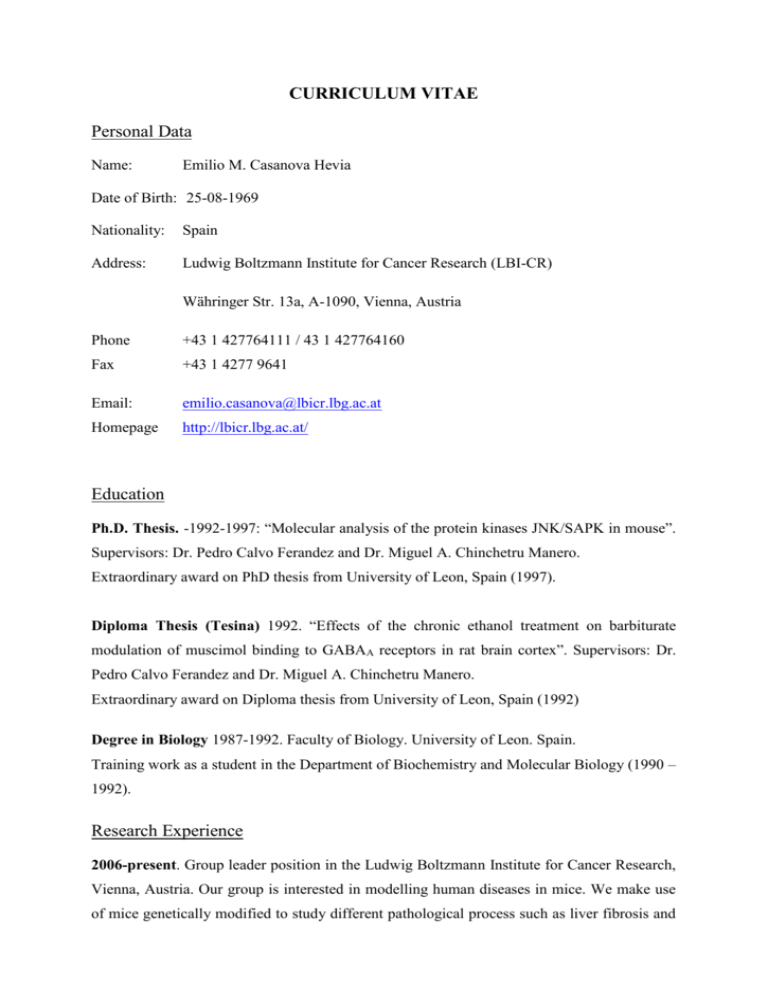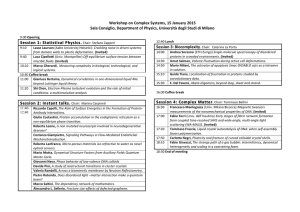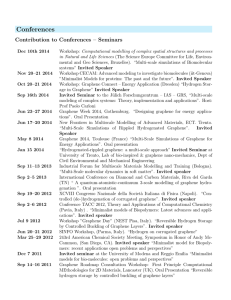CURRICULUM VITAE Personal Data Name: Emilio M. Casanova
advertisement

CURRICULUM VITAE Personal Data Name: Emilio M. Casanova Hevia Date of Birth: 25-08-1969 Nationality: Spain Address: Ludwig Boltzmann Institute for Cancer Research (LBI-CR) Währinger Str. 13a, A-1090, Vienna, Austria Phone +43 1 427764111 / 43 1 427764160 Fax +43 1 4277 9641 Email: emilio.casanova@lbicr.lbg.ac.at Homepage http://lbicr.lbg.ac.at/ Education Ph.D. Thesis. -1992-1997: “Molecular analysis of the protein kinases JNK/SAPK in mouse”. Supervisors: Dr. Pedro Calvo Ferandez and Dr. Miguel A. Chinchetru Manero. Extraordinary award on PhD thesis from University of Leon, Spain (1997). Diploma Thesis (Tesina) 1992. “Effects of the chronic ethanol treatment on barbiturate modulation of muscimol binding to GABAA receptors in rat brain cortex”. Supervisors: Dr. Pedro Calvo Ferandez and Dr. Miguel A. Chinchetru Manero. Extraordinary award on Diploma thesis from University of Leon, Spain (1992) Degree in Biology 1987-1992. Faculty of Biology. University of Leon. Spain. Training work as a student in the Department of Biochemistry and Molecular Biology (1990 – 1992). Research Experience 2006-present. Group leader position in the Ludwig Boltzmann Institute for Cancer Research, Vienna, Austria. Our group is interested in modelling human diseases in mice. We make use of mice genetically modified to study different pathological process such as liver fibrosis and cancer. Recently we have developed several mouse models for liver fibrosis and we are currently analyzing them. Also, by making use of mouse genetic technology, we have generated a mouse model for skin and brain hemangiomas. 2002-2006. Working as a postdoc in the Group of Dr. Bernhard Bettler, Biozentrum, Basel, Switzerland. My work focused on studying the trafficking of GABA(B) receptors using life imaging of primary neuronal cultures of genetically engineered mice expressing GABA(B)GFP fusion proteins. Simultaneously, we generated the knock-outs mice of two new discovered G protein-coupled orphan receptors to study their function on brain development and synaptic transmission (in collaboration with Novartis). 1997 – 2002. Working as a postdoc in the group of Dr. Günther Schütz, DKFZ, Heidelberg, Germany. During this period I studied the different signalling pathways in brain that activate the transcription factor CREB via phosphorylation. For this purpose, I generated transgenic animals using BAC technology to express constitutive and tamoxifen-inducible Cre recombinases in brain. I also generated conditional targeted mice of several putative CREB kinases. During this time I learned several techniques related to mouse genetics, such as mouse stem cell culture and manipulation, generation of transgenic mice via modified BACs or PACs, knock-out/knock-ins and conditional knock-out mice models. 1992 – 1997. During my PhD I learnt several techniques in Biochemistry and Molecular Biology including: Receptors binding assays, autoradiography, DNA cloning, RT-PCR, cDNA library screening, Southern and Northern blot, in situ hybridisation, preparation and purification of recombinant proteins, antibody generation, Western blot, ELISA and Immunohistochemistry. Publications 42. Mueller KM, Kornfeld JW, Friedbichler K, Blaas L, Egger G, Esterbauer H, Hasselblatt P, Schlederer M, Haindl S, Wagner KU, Engblom D, Haemmerle G, Kratky D, Sexl V, Kenner L, Kozlov AV, Terracciano L, Zechner R, Schuetz G, Casanova E, Pospisilik JA, Heim MH, Moriggl R. Impairment of hepatic growth hormone and glucocorticoid receptor signaling causes steatosis and hepatocellular carcinoma in mice. Hepatology. (in press) 41. Blaas L, Musteanu M, Grabner B, Eferl R, Bauer A and Casanova E. The Use of Bacterial Artificial Chromosomes for Recombinant Protein Production in Mammalian Cell Lines Methods in Molecular Biology (in press) 40. Mair M, Blaas L, Osterreicher CH, Casanova E, and Eferl R. JAK-STAT signaling in hepatic fibrosis Front Biosci. 2011 Jun 1;17:2794-811 39 Eckelhart E, Warsch W, Zebedin E, Simma O, Stoiber D, Kolbe T, Rülicke T, Mueller M, Casanova E*, Sexl V*. A novel Ncr1-Cre mouse reveals the essential role of STAT5 for NK cell survival and development. Blood. 2011 Feb 3;117(5):1565-73. *Equally contributed 38 Grabner B, Blaas L, Musteanu M, Hoffmann T, Birbach A, Eferl R and Casanova E. A mouse tool for conditional mutagenesis in ovarian granulosa cells Genesis 2010 Oct 1;48(10):612-7. 37. Guetg N, Aziz S, Holbro N, Turecek R, Riad S, Gassmann M, Moes S, Jenoe P, Oertner T, Casanova E and Bettler B NMDA Receptor-Dependent GABAB Receptor Internalization via CaMKII Phosphorylation of Serine 867 in GABAB1 PNAS, 2010 Aug 3;107(31) 36 Mair M; Zollner G; Schneller D; Musteanu M; Fickert P; Gumhold J; Schuster C; Fuchsbichler A; Bilban M; Tauber S; Esterbauer H; Kenner L; Poli V; Blaas L; Kornfeld JW; Casanova E; Mikulits W; Trauner M; Eferl R. Stat3 protects from liver injury and fibrosis in a mouse model of sclerosing cholangitis Gastroenterology. 2010 Feb 26 35 Musteanu M, Blaas L, Mair M, Schlederer M, Bilban M, Tauber S, Esterbauer H, Mueller M, Casanova E, Kenner L, Poli V and Eferl R1 Stat3 is a negative regulator of intestinal tumor progression in ApcMin mice Gastroenterology. 2010 Mar;138(3):1003-11 34. Blaas L, Kornfeld JW, Schramek D, Musteanu M, Zollner G, Gumhold J, Schneller D, Esterbauer H, Mair M, Kenner L, Mikulits W, Eferl R, Moriggl R, Penninger J, Trauner M and Casanova E. Disruption of the GH-STAT5-IGF-1 axis severely aggravates liver fibrosis in a mouse model of cholestasis Hepatology. 2010 Apr;51(4):1319-260 33. Birbach A, Casanova E and. Schmid JA. A Probasin-MerCreMer BAC allows inducible recombination in the mouse prostate Genesis 2009 Nov 47 32. Casanova E*, Guetg N*, Vigot R, Seddik R, Julio-Pieper M, Hyland NP, Cryan JF, Gassmann M and Bettler B. A Mouse Model for Visualization of GABA(B) Receptors. Genesis (2009) Jul 14 *Equal contribution 31. Blaas L, Musteanu M, Eferl R, Bauer A and Casanova E. Bacterial artificial chromosomes improve recombinant protein production in mammalian cells. BMC Biotechnol. (2009) Jan 14;9(1):3. 30. Wellendorph P, Johansen L, Jensen A, Casanova E, Gassmann M, Deprez P, ClementLacroix P, Bettler B and Bräuner-Osborne H. No evidence for a bone phenotype in GPRC6A knockout mice under normal physiological conditions. J Mol Endocrinol. (2008) Dec 22. 29. Bentzinger CF, Romanino K, Cloëtta D, Lin S, Mascarenhas JB, Oliveri F, Xia J, Casanova E, Costa CF, Brink M, Zorzato F, Hall MN and Rüegg MA Skeletal Muscle-Specific Ablation of raptor, but Not of rictor, Causes Metabolic Changes and Results in Muscle Dystrophy. Cell Metab. (2008) Nov;8(5):411-24. 28. Maison SF, Casanova E, Holstein GR, Bettler B and Liberman MC Lack of GABAB receptors in cochlear neurons suggests modulation of outer hair cell function by type-II afferent fibers J Assoc Res Otolaryngol (2008) Oct 17 27. Blaas L., Musteanu M., Zenz R., Eferl R. and Casanova E. PhiC31 Mediated Cassette Exchange into a BAC Biotechniques. (2007) Nov;43(5):659-60, 662, 664. 26. Lemberger T, Parlato R, Dassesse D, Westphal M, Casanova E, Turiault M, Tronche F, Schiffmann SN, Schutz G. Expression of Cre recombinase in dopaminoceptive neurons. BMC Neurosci. (2007) Jan 3;8(1):4 25. Yuan X, Zhou Y, Casanova E, Chai M, Kiss E, Grone HJ, Schutz G, Grummt I. Genetic Inactivation of the Transcription Factor TIF-IA Leads to Nucleolar Disruption, Cell Cycle Arrest, and p53-Mediated Apoptosis. Mol Cell. 19 (2005) 77-87. 24. Alberti, S., Krause, SM., Kretz,O., Philippar, U., Lemberger,T., Casanova, E., Wiebel, FF., Schwarz, H., Frotscher, M., Schütz,G., and Nordheim, A. Neuronal migration in the murine rostral-migratory stream requires serum response factor Proc Natl Acad Sci U S A. 102 (2005) 6148-53 23. Callejo AI, Casanova E, Calvo P, Galetto R, Rodriguez-Rey JC, Chinchetru MA. Characterization of the promoter of the mouse c-Jun NH(2)-terminal/stress-activated protein kinase alpha gene. Biochim Biophys Acta. 24 (2004) 47-52 22. Z. Zhang, C. Hofmann, E. Casanova, G. Schütz and B. Lutz Generation of a conditional allele of the CBP gene in mouse Genesis 40 (2004) 82-89 21. C. Haller*, E. Casanova*, M. Müller*, C. Vacher, R. Vigot, S. Barbieri, M. Gassmann, and B. Bettler A Floxed Allele for Conditional Inactivation of the GABAB(1) Gene Genesis 18 (2004) 125-130 *Equal contribution 20. Marsicano G, Goodenough S, Monory K, Hermann H, Eder M, Cannich A, Azad SC, Cascio MG, Gutierrez SO, van der Stelt M, Lopez-Rodriguez ML, Casanova E, Schutz G, Zieglgansberger W, Di Marzo V, Behl C, Lutz B. CB1 cannabinoid receptors and on-demand defense against excitotoxicity. Science 302 (2003) 84-88 19. E. Casanova, S. Fehsenfeld, T. Lemberger and G. Schütz Alpha complementation in the Cre recombinase enzyme Genesis 37 (2003) 25-29 18. F. Tronche, E. Casanova, M. Turiault, I. Sahly, C. Kellendonk When reverse genetics meets physiology: the use of site-specific recombinases in mice FEBS Lett. 529 (2002)116-121 17. E. Casanova*, S. Fehsenfeld, T. Lemberger, D. R. Shimshek, R. Sprengel and T. Mantamadiotis A Er-based Double iCre Fusion Protein Allows Partial Recombination in Forebrain Genesis 34 (2002) 208-214 *Corresponding author 16. E. Casanova, S. Fehsenfeld, E. Greiner, A. F. Stewart and G. Schütz Conditional Mutagenesis of CamKIV Genesis 32 (2002) 161-164 15. E. Casanova, S. Fehsenfeld, E. Greiner, A. F. Stewart and G. Schütz Construction of a Conditional Allele of RSK-B/MSK2 in the mouse Genesis 32 (2002) 158-160 14. D.R. Shimshek, J. Kim, M.R. Hübner, D.J. Spergel, F. Buchholz, E. Casanova, A.F. Stewart, P.H. Seeburg and R. Sprengel Codon-improved Cre recombinase (iCre) expression in the mouse Genesis 32 (2002) 19-26 13. E. Casanova, T. Lemberger, S. Fehsenfeld, E. Greiner and G. Schütz Rapid localization of a gene within BACs and PACs Biotechniques 32 (2002) 240-242 12. E. Casanova, S. Fehsenfeld, T. Mantamadiotis, T. Lemberger, E. Greiner, A. F. Stewart, G. Schütz allows brain-specific gene inactivation Genesis 31 (2001) 37-42 11. E. Casanova, A.I. Callejo, P. Calvo P, M.A. Chinchetru Analysis of splicing of four mouse JNK/SAPKalpha variants. Neuroreport 11 (2000) 305-309 10. M.A. Chinchetru, E. Casanova and P.Calvo Stress-activated protein kinases ( JNK/SAPKs) of mammalian brain Trends in Comparative Biochem.and Physiol. 4 (1998) 255-259 9. C. Kellendonk, F. Tronche, E. Casanova, K. Anlag, C. Opherk and G. Schütz Inducible Site-specific Recombination in the Brain J. Mol. Biol. 285 (1999)175-182 8. A. Alonso-Llamazares, J. Lopez-Alonso, M. del Barrio, E. Casanova, P. Calvo, MA. Chinchetru. Cloning of chicken and mouse a1b adrenergic receptor Biochim. Biophys. Acta 1396 (1998) 263-266 7. A. Alonso-Llamazares, E. Casanova , D. Zamanillo, S. Ovalle, P.Calvo and MA: Chinchetru. Phosphorylation of the third intracellular loop of the mouse a1b- Adrenergic receptor by cAMP-dependent protein kinase. Brain Res. Bull. 42 (1997) 427-430 6. E. Casanova, C. Garate, S. Ovalle, P.Calvo and MA. Chinchetru. Identification of four splice variants of the mouse stress activated protein kinase JNK/SAP a isoform. NeuroReport 7 (1996) 1320-1324 5. E. Casanova, A. Alonso-Llamazares, D. Zamanillo, C. Garate, P. Calvo and MA. Chinchetru. Identification of a long huntingtin mRNA transcript in mouse brain. Brain Res. 743 (1996) 320-323 4. S. Ovalle, E. Casanova, C. Garate, A. Alonso-Llamazares, MA. Chinchetru and P. Calvo Immunodetection of serotonin transporter from mouse brain. NeuroReport, 6 (1995) 2353-2356 3. A. Alonso-Llamazares, D. Zamanillo, E. Casanova, S. Ovalle, P. Calvo, M.A, Chinchetru. Molecular cloning of a1d-adrenergic receptor and tissue distribution of tree a1-adrenergic receptors subtypes in mouse. J. Neurochem. 65 (1995) 2387-2392 2. D. Zamanillo, E. Casanova, A. Alonso-Llamazares, S. Ovalle, MA. Chinchetru and P. Calvo. Identification of a cyclic adenosine 3´, 5´-monophosphate-dependent protein kinase phosphorylation site in the carboxy terminal tail of D1 dopamine receptor. Neurosci. Lett. 188 (1995) 183-186 1. M. Negro, E. Casanova. M.A. Chinchetru, A. Fernadez-Lopez and P Calvo. Differential effect of chronic ethanol treatment on barbiturate and steroid modulation of muscimol binding to rat brain cortex. Neurosci. Lett. 158 (1993) 83-86 Grants: Period Organization Short title €/year 20092012 Austromouse BAC recombineering to generate compound Stat3/Stat5 double knock-out mice and functions of Stat3 in colorectal cancer 61.333 20112014 FFG-Bridge BAC-based Expression System Technology 177.000 Patents: Title: “Method fort he generation of a non-human animal with an oncogene” Application number: 07450118.0-2405 Date: 2.07.07 Applicant/Proprietor: Ludwig Boltzmann Gesellschaft GmbH Inventors : Robert Eferl, Emilio Casanova, Dagmar Stoiber, Richard Moriggl, johannes Schmid, Lukas Kenner, Rainer Zenz, Monica Musteanu and Leander Blaas Title: “Artificial Chromosome Vector” Application number A 1859/2008 Date 28.11.2008 Applicant/Proprietor:Emilio Casanova, Anton Bauer Inventors: Leander Blass, Anton Bauer, Emilio Casanova Seminars and conferences Invited speaker: Controlling gene expression inducible in mice: conditional mutagenesis, inducible expression and RNAi. October 2004 Marseille, France EMBL Mouse Molecular Genetics Meeting, September 2005, EMBL, Heidelberg, Germany Invited speaker: “Conditional Gene Targeting” March, 2005 Leibniz Institute for Age Research – Fritz-Lipmann-Institute. Jena, Germany Invited speaker: 11th Scientific Symposium of Austrian Pharmacology Society (APHAR) Vienna September 2005 Invited speaker: "Life Imaging of GABA(B) Receptors" February, 2007 Leibniz Institute for Age Research – Fritz-Lipmann-Institute. Jena, Germany Invited speaker:"Analysis of GABA(B) Receptors" February, 2007. Leibniz Institute for Age Research – Fritz-Lipmann-Institute. Jena, Germany Invited speaker: “Life imaging of GABA(B) Receptors in vivo” October 2007. Instituto de Biología y Genética Molecular, Valladolid, Spain. Invited speaker: “Life imaging of GABA(B) Receptors in vivo” May 2008. Instituto de neurociencias, Alicante, Spain . Invited speaker: “Role of Stat5 in liver fibrosis” September 2008. “Research Retreat in Sopron”, Hungary. Invited speaker: “Role of Stat5 in liver fibrosis” January 2009. Collège de France, Paris, France. Invited speaker: “Role of Stat5 in liver fibrosis” April 2009. “Research Retreat Vienna”, Austria. Invited speaker: “Role of Stat5 in liver fibrosis” April, 2009. Faculty of Pharmaceutical Sciences, Copenhagen, Denmark. Invited speaker: “Role of Stat5 in liver fibrosis” May 2010. Leibniz Institute for Age Research – Fritz-Lipmann-Institute. Jena, Germany. Invited speaker: “Mouse models for cancer and liver fibrosis” September 2010. “Research Retreat in Sopron”, Hungary. Invited speaker; life imaging of GABAB Patras October 2010 References: Prof. Miguel Chinchetru University of Leon Leon Spain Phone: +34 987 29 1223 Email; dbbmcm@unileon.es Prof. Günther Schütz German Cancer Research Center Heidelberg Germany Phone: +49 6221 42 3422 Email: g.schuetz@dkfz.de Prof. Bernhard Bettler Pharmazentrum/Biozentrum University of Basel Basel Switzerland Phone +41 61 267 16 32 Email bernhard.bettler@unibas.ch Prof. Markus A. Rüegg Neurobiology Biozentrum, University of Basel Klingelbergstrasse 50/70 CH-4056 Basel / Switzerland Phone +41 61 267 22 23 Email markus-a.ruegg@unibas.ch

